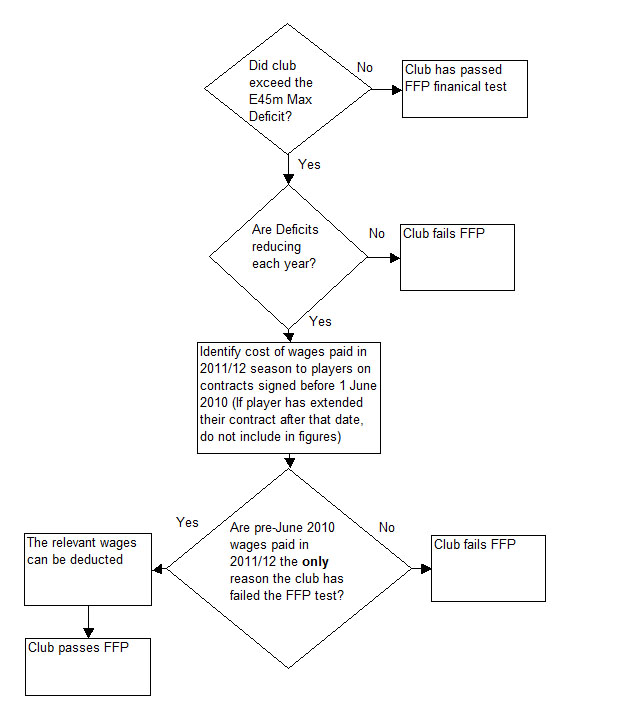If losses are 'trending in the right direction' will a club pass the FFP test?
It is quite common to read journalists state that a club will pass the FFP test if it is 'trending in the right direction' (i.e losses are reducing each year). However this is probably the single biggest misconception about the FFP rules. The confusion is due to something called Annex XI, a rather tortuously worded post-script added to the FFP rules specifically to help clubs comply with FFP in the early years. The most common incorrect beliefs are:
| Incorrect FFP beliefs | |
| 1 | As long as the club is trending in the right direction and the losses are reducing, the FFP test is passed. |
| 2 | The wages of all players signed before 1 June 2010 are excluded from the calculations for every season |
Annex XI is found on the final page (page 87) of the long UEFA document. However I have extracted the relevant paragraphs (although it is hard going for such a short section).
UEFA FFP Wage Exclusion paragraph: Annex XI
Annex XI explained
I feel the problematic paragraphs are best explained in my diagram relating to the first Monitoring Period (where the Maximum permitted Break Even Deficit is E45m):

As we can see, if the Break Even Deficits are trending in the right direction, the club can look to exclude wages for long-standing players (i.e. those still on contracts signed before June 2010) to help them pass the test.
Note that this potential exclusion only applies only to the wages for the long-standing players paid during the one season (2011/12). For example, Tevez' wages would have to be included in full for the current 2012/13 season.
So to recap, trending in the right direction, in itself will not be enough to ensure a club passes the FFP test. 'Trending' simply allows a club to deduct wages for long-standing players paid in the season just-finished (2011/12).
This part of the rules is so-often misunderstood that I feel it is worth including some confirmation from top sports Lawyer Daniel Geey @FootballLaw from Twitter late yesterday. On this subject he said:
1..articles make reference to Annex X1 sanction examples
2. Clubs will not be sanctioned IF they have positive cost trend AND would have broken-even had it not been for pre-June '10 contracts.
3. An Annex XI positive trend by itself will not be enough to escape UEFA sanctions.
One final piece on Annex XI. Although the Annex allows the club to exclude wages from players signed before 1 June 2010, there is another reading that could, potentially help clubs; the exclusion could also extend to amortisation as well as wages. However, this is not the generally accepted reading of this and it does not appear to have been UEFA’s intention to exclude both amortisation and wages on the long-standing player
N.B. Where I refer to Max Deficit of E45m in the above diagram, I am referring to the 'Break Even Deficit' - this isn't the same thing as the total loss a club makes as it able to make a number of exclusions from the Break Even calculations (e.g. expenditure on youth and community development).
blog comments powered by Disqus
